General Care & Wellbeing
Activities to keep kids entertained that actually create functional exercise
Being cooped up at home can be challenging in so many ways. For many kids home from school, the important opportunities they get to be physically active on a daily basis have diminished.
Balancing working from home with caring for your little ones is tricky, especially with all the conveniences of modern technology continuing to seduce us into an increasingly sedentary lifestyle.
Keeping active is more important than ever. Especially for our kids.

Here at Step Into Health Care your health and that of your family is our top priority. Here we provide some ideas, links to activities and exercises that can get you and your family moving and stimulated:
- Get moving outside – although the playgrounds are closed there is still an abundance of outdoor spaces where kids can play and be physically active whilst keeping you distance. Try a nature walk through one of your favourite reserves or urban bushland spaces. A simple walk around your neighbourhood will even do the world of good. Just remember to follow to the governments social distancing guidelines.
- Check out PE with Joe for your daily 30 minute kid friendly physical exercise routines that can be easily done in the comfort of your own home Click Here to View
- Obstacle course – create your own incorporating functional exercises – jumping, lifting, squatting and bending. Use your imagination as you can make a new course daily.
- Song and dance- classics like hokey pokey or just ‘shake it off’ freestyle to some of your more modern favourite tunes.
- Simon says is great game to play as you are using functional exercise in a fun way and the kids won’t even know it’s good for them – Simon says touch your toes, reach up high!
- Cosmic kids yoga is a fun and exciting way to keep your kids moving in a more structured and calm way using very recognisable themes to get them even more interested – Click Here to View
As part of your musculoskeletal Telehealth treatment plan your practitioner will check in your regular exercise and movement patterns and may provide advice accordingly.
Book online today at www.stepintohealthcare.com.au where your health is our top priority!
Dietary and nutritional advice
Families and households are spending more time together. This is a good opportunity to adopt healthy eating practices which may boost your general immunity. Look at this time as a dietary starter, an occasion to get kids involved in the kitchen and sit down as a family at the dinner table.
This is something your practitioner may be able to cover during one of your Telehealth appointments. They may also be able to share and trade some great recipes with you!

The WHO has useful guidelines to adopt during the COVID-19 time summarised below*:
- Make a plan and buy only what you need at the shop – this means you spend less time at the shop and prevents over buying
- Prioritise your meals and use fresh products first
- Prepare home cooked meals – just like Mum makes, they are always the best
- Be aware of portion sizes and grazing whilst at home – especially if you are stressed or have extra time on your hands
- Follow safe food handling procedures – keep you kitchen, hands and surfaces clean and tidy
- Reduce salt intake – many processed, canned or frozen foods already contain high levels of salt. The WHO recommends consuming <5g of salt per day
- Reduce sugar intake – The WHO recommend <5% of your total energy intake should come from free sugars (about 6 teaspoons). If your looking for something sweet reach for fresh fruit, dried or frozen fruits
- Limit your fat intake – WHO recommends that <30% of your total energy should come from fats and 10% of that should be from saturated fat. So that means less hot chips and fried foods! Instead steam or grill where possible. Fish and nuts are better sources of fats. Trans fats found in frozen pizzas, biscuits and baked goods should be avoided as much as possible
- Consume enough fibre – this contributes to a healthy digestive system and makes you feel full to prevent overeating. Include as many vegetables, fruit, wholegrain foods such as oats, brown pasta and rice and brown bread.
- Stay hydrated – tap water is the best, 2-3L/day according to https://www.betterhealth.vic.gov.au/health/healthyliving/water-a-vital-nutrient
- Avoid and reduce alcohol – although many think it helps deal with stress, it actually does the opposite, lowers your immune defences, affects your mind and can interact with some medications
As part of your Telehealth treatment plan your practitioner may be able to help tailor your dietary needs and make sure you eating and drinking the right things, not the wrong ones.
Book online today at www.stepintohealthcare.com.au where your health is our top priority!
*Further information can be found from the WHO http://www.euro.who.int/ru/health-topics/health-emergencies/coronavirus-covid-19/novel-coronavirus-2019-ncov-technical-guidance/food-and-nutrition-tips-during-self-quarantine
Are you now working from home?
Missing your office comforts? Using your laptop on the kitchen table or lounge doesn’t count as good ergonomics! This and other poor ergonomic setups may cause you musculoskeletal problems very quickly.
Here at Step Into Health Care our team want to help you ensure you have the best ergonomic setup possible while working from home during this COVID-19 time. Given there was little time for workers to organise their desk setup at home, source or bring with them essential pieces of equipment we are able to give you the advice, tools and resources needed to prevent injury.
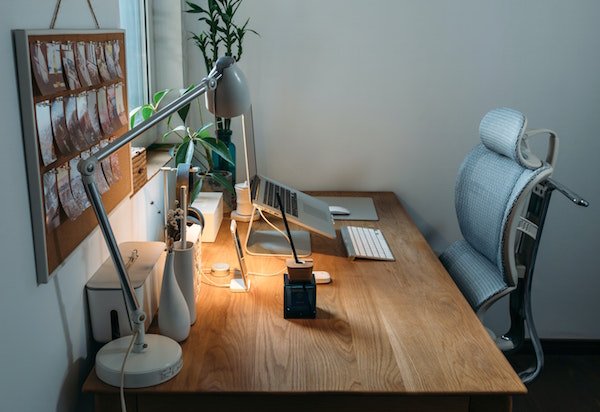
What we can provide:
- Advice and recommendations based on professional training
- A video Telehealth review of your workstation
- Guidelines emailed to you
- A review of musculoskeletal aches and pains you may be feeling from your current ergonomics
- Stretching and exercise programs
- Self help advice and techniques
Some of our tips from Eoin our Physio that can help you:
- Make yourself a cup of tea – this has two benefits in that you need to go to the kitchen to make it and it will also make you need to use the bathroom, both of which will get you away from the computer.
- Remember to take your morning tea break and, when possible, spend some time outside.
- At some point during the day, make some time to talk to another person (phone call or in person depending on your situation), whether it be a spouse, child, parent or friend, making the effort to talk to another person will help break up your day and will help you manage your mental health.
- Avoid resting on your elbows while working, if you feel that you need to rest your elbows on the desk it is likely that your chair is not set to the correct height. When setting up your office chair and desk, your thighs should be supported up to 5cm behind the back of your knee, your knees should be slightly below your hips and the desk should be comfortably below your elbow height in a resting position. Consider the use of a lift if your chair set up does not meet these criteria.
- Avoid being too sedentary – this may cause musculoskeletal issues or other general health problems. As a guide, for every 30 minutes spent sitting, more than 2 minutes should be spent moving.
- Check your workstation every day, especially if you share it with others or your children
- Equipment – move your equipment based on the task you are doing. Keep your mouse close to you, ideally a wireless mouse is best. Use a document holder. Use a headset or ear buds and don’t hold the phone to your ear
- Screen – keep it clean, adjust the brightness settings
- Sit stand stations – alternate from sitting to standing every 30 minutes, rather than every half day. Standing stations can be a high bench at home, or even your ironing board (it’s adjustable!)
- Laptops/smartphones/tablets – these are very poor for ergonomics. Ensure you use an external mouse, keyboard and lift the screen up. Take more regular breaks and don’t hold them for extended periods or use a rest.
- Ensure the general lighting, temperature and airflow of your workspace is adequate
- Always maintain your best posture at your desk
- Reduce repetitive stress motions –use short-cut keys or macros to reduce repetition and mouse clicks
- Set reminders on your computer to stop, move and do some stretches
- Get a family member to assess your ergonomics if your workplace does not have such facilities for home offices
- We came across this handy business supplying office furniture at reasonable prices. Flat packed and sent to you! https://www.stagekings.com.au/store
Book a Telehealth appointment today and we can check you are doing all the right things and not the wrong things while working from home!
Book online today at www.stepintohealthcare.com.au where your health is our top priority!
Immune Boosting
In this current time, it is important to think about your immune system and keeping it in good shape. As Osteopaths, we can offer some basic and straightforward pointers.
Here are some tips to help strengthen your immune system and help protect yourself from many types of viruses.

Everyday activities:
- Proper handwashing: the coronavirus is killed by proper handwashing for 20 seconds with soap or using hand sanitizer that is greater than 60% alcohol.
- Don’t smoke: Smokers have an increased risk of catching infections and suffering severe complications from those infections.
- Get adequate sleep: Sleep and immunity are closely tied. Research from the WHO shows that sleep-deprived people can have suppressed immunity, meaning that they’re more at risk of catching viruses. Adults should aim for a minimum of 7 hours sleep per night.
- Stay hydrated: Given that dehydration can make you more susceptible to illness, make sure you’re drinking plenty of water each day. Check out our nutrition page for further information.
- The right amount of exercise: Observational studies show that those who exercise tend to suffer fewer infections than those who do not. Stay active, but don’t start a new high intensity exercise routine.
- Stress: Chronic stress may decrease immune function. Worrying about not having enough toilet paper or focusing on the uncertainties of the future can raise cortisol levels, which may negatively impact your immune function. Meditation, mindfulness exercises, and getting outside and going for walks are examples that are free to do and relatively easy to help with stress management
Supplements:
No supplement will cure or prevent disease, including COVID-19, but some may improve immune response. Here are some supplements that have some potential to boost your immune system:
- Echinacea is used in traditional western herbal medicine to relieve the severity of symptoms of mild upper respiratory tract infections and support healthy immune function.
- Vitamin C plays an important role in normal immune function.
- Zinc provides nutritional support for the functioning of a healthy immune system.
- Andrographis help to reduce the symptoms associated with mild upper respiratory tract infections, including sore throat.
- Olive leaf is traditionally used in western herbal medicine to relieve mild fever.
We hope everyone stays safe and healthy in this current time. If you require any more advice or any immune boosting supplements, you can easily book a Telehealth appointment.
We also stock a range of quality supplements from Bioceuticals and Spectrumceuticals including immune boosting supplements with all the essential ingredients discussed above.
Also remember that the advice we provide is general in nature and if you are suffering from signs of an immune related condition you must seek medical advice.
Book a Telehealth appointment today and we can check you are doing all the right things and not the wrong things while working from home!
Book online today at www.stepintohealthcare.com.au where your health is our top priority!
Mental Health
Keeping on top of your mental health, including those close family members, friends or household members is very important during COVID-19.
There are many links between the mental and physical health of an individual that can significantly impact their quality of life. Here from our team are:
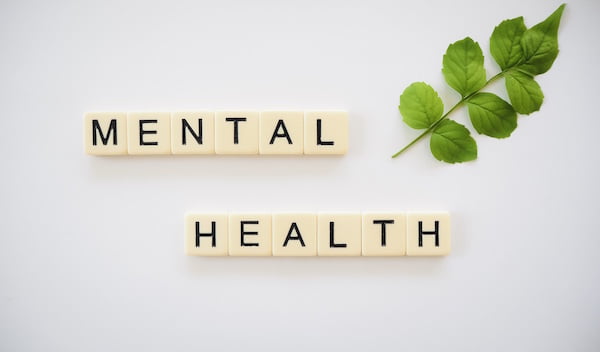
9 tips to support your mental health during the COVID-19 outbreak*
- Aim for perspective – whilst it is important to acknowledge the declared pandemic, bear in mind that there are medical and health experts all around the world working hard to contain the virus, provide treatment and develop a vaccine as quickly as possible.
- Get the facts – access your information from reputable sources. If you are feeling overwhelmed from all the negative media coverage, consider limiting media intake if it is causing you and / or family stress.
- Try to maintain a calm approach – panic can alter your coping mechanisms and may also affect the people around you. Do your best to remain calm. Follow official guidelines, practice good hand hygiene, social distancing and stay home orders when needed.
- Check in on family / friends / neighbors – compassion and kindness never go out of fashion. Isolation and loneliness can be huge stressors on our emotional state and immune system. A lot of parents are facing job loss or having to juggle jobs with the immediate transition of becoming a teacher. Reach out.
- Play – whether it’s dancing in the kitchen, doing an obstacle course with your kids in the living room, improvising on your new home-gym set up, pulling faces in the mirror or going for a bush walk – play is one of the quickest ways to reverse anxiety, fear and anger.
- Unwind your mind – relish the down time. Use any free time to practice activities that nurture your mind and emotional health. Meditation, yoga, mindfulness and creative projects may be soothing. There is a wealth of information that can be found online and on apps. For the ultimate de-stress consider unplugging your electronic devices, giving you a chance to focus on yourself again.
- Ask for help – it’s OK to not be OK. Seek mental professional help when needed. Below is a list of useful resources.
- Take stock – thank those truly in the front-line. Be grateful you are reading this and not in a worse position.
- *Seek professional help if required – If you or someone you know is suffering from or has a suspected mental illness, please consult your GP or medical expert as soon as possible.
Here are some mental health resources you may find useful:
https://www.who.int/docs/default-source/coronaviruse/mental-health-considerations.pdf
https://www.smilingmind.com.au/
https://www.mentalhealth.org.nz/get-help/covid-19
Keeping up to date with the latest facts is very important:
https://www.healthdirect.gov.au/coronavirus
https://www.who.int/emergencies/diseases/novel-coronavirus-2019/situation-reports/
The COVID-19 hotline number in the ACT is 02 6207 7244 and is staffed between 8am-8pm daily.
If there is an emergency dial 000 for urgent medical help.
Book a Telehealth appointment today and we can check you are doing all the right things and not the wrong things while working from home!
Book online today at www.stepintohealthcare.com.au where your health is our top priority!
Sleep advice
With the stresses and strains from COVID induced changes to our daily lives and routines, you may be noticing sleep a little hard to find.
Staying awake? Waking up? Worrying? Tossing and turning?
Sleep is an important part of our mental health and is important in our physical recovery.

Here at Step Into Health Care, your overall health is our top priority. Here Osteopath Dr Tom Eastman provides some practical ways from the Transcultural Mental Health Centre* to help improve your sleep:
1.Establish a regular waking time – A regular sleep/wake pattern is very important, especially waking at the same time each morning. The time that we wake helps to synchronise our body’s circadian rhythms, so we should try not to vary the time of the day that we get up by more than one hour, even across the weekends.
2. Establish a proper sleep environment comfort – The discomfort caused by a rumbling stomach, persistent aches and pains, or being too hot or cold, can prevent us from relaxing enough to fall asleep. Therefore it is necessary that all our immediate needs have been met before we try to sleep. Reducing noise and light when sleeping can help.
3.Allow a wind-down time prior to sleep – We should stop work at least 30 minutes before going to bed and do something different and non-stressful, such as reading and avoiding screen time.
4. Associating your bed with sleep – Activities such as eating, working, watching television, reading, or discussing the day’s problems may make us associate our bed with wakefulness and alertness rather than drowsiness and sleep onset.
5. Coping with worry and anxiety – One of the most common causes of sleep disturbance is anxiety. Many people find it difficult to wind down when they climb into bed at night after a hectic day. Relaxation methods can help reduce this.
6. Wait till you are sleepy – If you have problems falling asleep, consider going to bed only when you are sleepy. If you find yourself still awake and worrying after 10 minutes, get up and do something that is distracting yet relaxing, like knitting, listening to music, or reading a book. You may even want to listen to a relaxation podcast. Return to bed when you feel sleepy again.
7. Avoid napping during the day – It is not uncommon for people who have had a particularly bad night’s sleep to feel sleepy the next day. This daytime sleepiness can make it very tempting for you to take a nap during the day. However, if you have insomnia and nap in the daytime, you make it much more likely that you will have another night of poor sleep.
8. Avoid caffeine – This drug is found in coffee, tea, cocoa, cola drinks, as well as some over-the-counter medications. Consuming caffeine before bedtime, or drinking too much caffeine during the day will increase feelings of energy and wakefulness and make it more difficult for you to fall asleep. Any caffeine consumed after about 4p.m. will have an effect by the time you go to bed.
9. Avoid nicotine – Nicotine stimulates the nervous system by releasing a hormone called ‘adrenaline’. Adrenaline acts to arouse the body and mind, making you alert and ready for action. Smoking prior to bedtime increases energy and liveliness at the very time when you want to be relaxed and ready for sleep.
10. Avoid excessive alcohol – A popular belief about alcohol is that it will help you sleep if you are uptight and anxious. One or two glasses of wine in the evening may help you to relax, but regularly having several drinks in the evening causes you to get much poorer sleep overall.
11. Avoid sleeping pills – The use of sleeping pills for any length of time causes as many problems as it solves. While sedative hypnotics will help you fall asleep and will decrease your anxiety in the short term, these benefits will disappear in the long term if you continue to use sedatives regularly.
As part of your musculoskeletal Telehealth treatment plan you practitioner will check in on how you are sleeping, give you some tips and refer you if necessary.
Book online today at www.stepintohealthcare.com.au where your health is our top priority!
*Further information can be found at: https://www.aci.health.nsw.gov.au/__data/assets/pdf_file/0009/404865/ENGLISH-A-Practical-Guide-Sleep.pdf
COVID Care Exercise Section
Welcome to the Home of Home Workouts from The Body Coach
Active 8 Minute Workout 1 | The Body Coach TV
This 8 minute workout is ideal for kids and families schooling from home who are missing their PE classes and need to burn off some energy and keep fit.

Beginners Workout | Low Intensity | Low Impact
In this video Joe provides a beginners level routine you can do at home.
These free videos from The Body Coach are a great resource to maintain your fitness and mobility at home. Remember warm up and cool down are to be followed. The level of exercise chosen must be appropriate to your level of fitness and ability. If you are feeling pain or experiencing any problems, get in touch with your Osteopath today.

Some helpful exercises and stretches from our Physio Eoin to protect your neck, shoulders and back
Gentle neck range of motion:
- Start in a comfortable sitting position
- Bring your chin as close to your chest as you can manage and hold this position for 6 seconds – perform 6 times
- Look up to the ceiling as high as you can manage comfortably and hold this position for 6 seconds – perform 6 times
- Bend your neck to the side and bring your ear towards your shoulder, hold this position for 6 seconds – perform 6 times (this movement is to be completed to both the right and left side)
- Keeping your eyes level, turn your head and look over your shoulder. Hold this position for 6 seconds – perform 6 times (this movement is to be completed to both the right and left side)
Thoracic mobility
It is important to maintain good movement in your upper-mid back.
If you have one available, use a foam roller and gently rock back and forth while positioning the roller between your shoulder blades.
If you do not own a foam roller, roll up a towel and lay it along your spine (as shown) – 30-60seconds 1set
Shoulder re-positioning:
Avoid slouching wherever possible as this places a significant strain on your neck and back muscles.
Perform the following exercises every day to help with your posture
Shoulder blade squeezes – 10reps 3sets
Pushup plus against a wall – 10reps 1set
Shoulder abduction and flexion – 10reps 2sets
Self Massage Techniques – For 7 Body Parts
© Yvette Croft, Remedial Massage Therapist, 20/4/2020
Need that Remedial Massage feeling but can’t get out of the house? Spending more time at home and sitting at a computer is already taking its toll on aches and pains.
Yvette Croft our Remedial Massage Therapist recommends to try some of these self massage techniques to give yourself some pain relief.
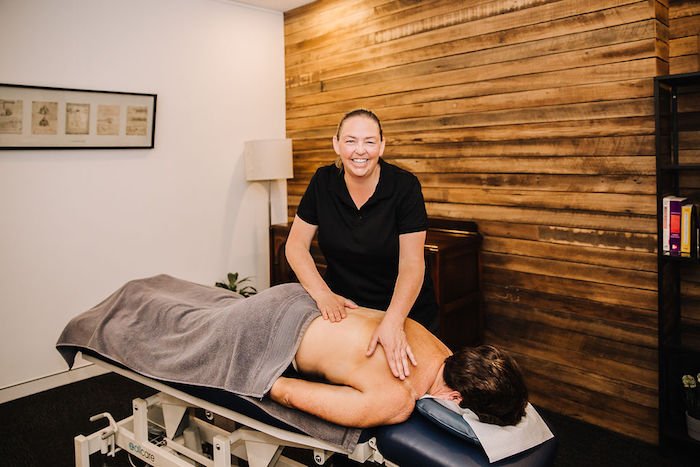
What are Self Massage Techniques?
Self massage techniques are techniques that you can do yourself to get rid of muscle tightness and aches throughout your body.
Many self massage techniques can be performed with your fingers, hands, and elbows, while others require simple items such as a massage ball/tennis ball or foam rollers.
You can do self massage techniques pretty much anywhere including your home, office, or even your car.
A few things to keep in mind when using self massage techniques:
1. You only need to massage for a few moments for mild cases; or a minute or two for more severe cases. Massage the area at least twice per day.
2. Explore the muscles in the area where you feel pain until you find the specific spot that is especially painful.
3. Apply pressure that is firm, but tolerable (tip: start with light pressure and work your way up).
4. If you experience pain afterwards ease up the next time you apply self treatment.
5. Gently stretch out the area after self massage treatment.
- If you have any queries, make sure you get in touch with your practitioner or book an online Telehealth appointment for advice.
1. Head Self Massage
For Head Self Massage
Nothing can ruin a perfect day like a throbbing headache. Try this simple self massage technique to relieve your head pain.
What you’ll need – Your Hands
How to do it:
- Place your thumbs high on your cheekbones, by your ears.
- Gently apply pressure in a circular motion with your fingertips to your temples.
- Continue making circles as your move along your hairline, until your fingertips meet in the middle of your forehead.
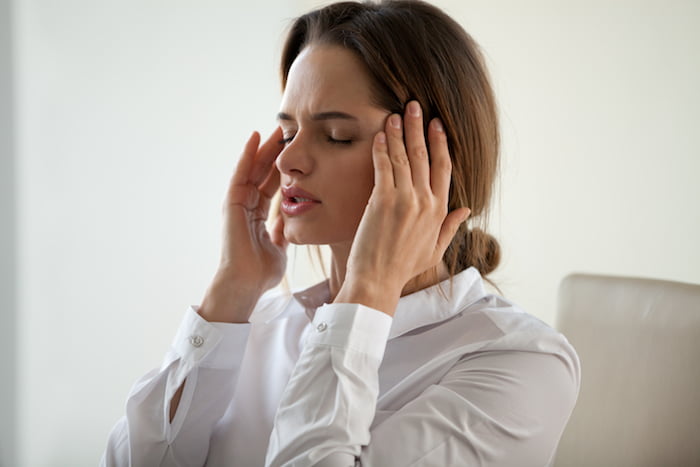
2. Neck Self Massage
For Neck Self Massage
Sitting at a computer all day can make your neck stiff and sore, doing this simple self massage technique will help to relieve tension and ease your pain.
What you’ll need – Your Hands
How to do it:
- Place two or three fingertips on the back of your neck where your neck meets your shoulders.
- Apply firm pressure and hold the area.
- Release when the muscle feels more relaxed.
- Roll your shoulders forwards and back slowly.
- Repeat two or three times.
3. Shoulder Self Massage
For Shoulder Self Massage
Poor posture and hunching at a desk all day can lead to rounded shoulders and shoulder pain. Doing this simple self massage technique can help to alleviate your pain.
What you’ll need – Your Hands
How to do it:
- position the fingers of your right hand over your right shoulder (your upper trapezius will be underneath your palm).
- squeeze your upper trapezius three times and then roll your fingers over the muscle starting from the outside and moving towards the base of your neck.
- repeat on your left side.
4. Hand Self Massage
For Hand Self Massage
Whether you sit at a computer typing all day or do a job that involves using your hands repetitively, your hands may be aching at the end of the day. Learning how to self massage your hands can help to relieve tension.
What you’ll need – Your Hands
How to do it:
- begin by placing your fingers over your wrist, as if you’re taking your pulse, and apply a side to side pressure across your wrist.
- move to the heel of your palms and start applying pressure in a small circular motion, working your way from the pinky finger side and moving towards your thumb side.
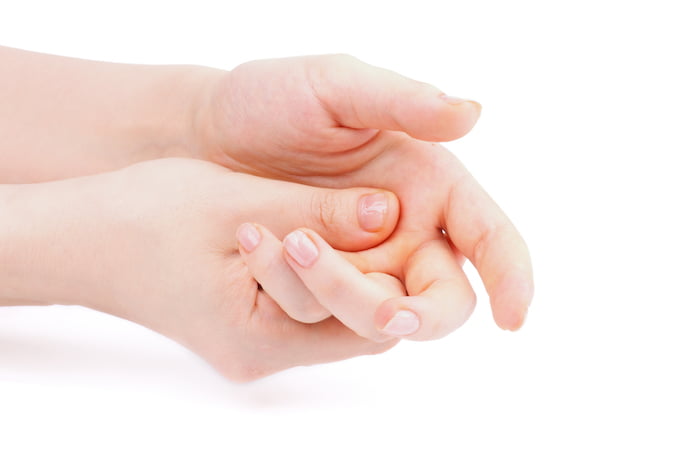
- next, grasp the web of tissue that connects your thumb to the rest of your fingers and gently move it up and down.
- then apply pressure by using a small circular motion to the muscles at the base of your fingers.
- next move up each finger using small circular strokes.
- once you reach your fingertip, gently pull the finger to stretch the joints.
- perform on both sides.
5. Lower Back Self Massage
For Lower Back Self Massage
Lower back pain is a very common complaint and can be disabling in some cases. Unfortunately, everyday activities such as cleaning and gardening can make your lower back pain even worse. You can alleviate your lower back pain by doing this quick technique.
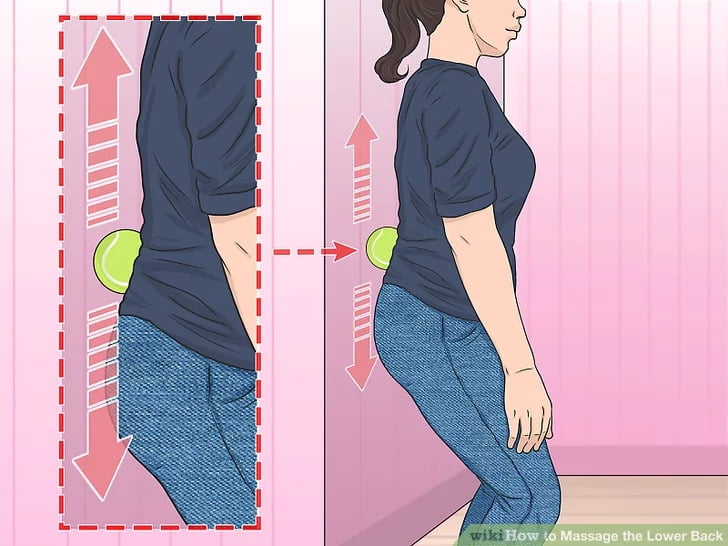

What you’ll need – A massage ball/tennis ball and wall
How to do it:
- Position a massage ball/tennis ball between your lower back and a wall.
- Move your body up and down, or side to side to find areas of tension.
- Apply a stronger pressure in the tender spots to help release the tension.
6. Foot Self Massage
For Foot Self Massage
Running, jogging and prolonged walking can be torturous for your feet. By the end of the day, your feet may be aching. The good news is that your foot pain can be relieved with this simple exercise.
What you’ll need – Massage Ball or Tennis Ball
How to do it:
- sit in a comfortable chair with your feet bare or with a sock on.
- position the tennis ball under your foot.
- roll back and forth from heel to toe using firm pressure.
- if you come across a painful or tender area, work the knot out by rolling in small circles.
- do this exercise on both of your feet.
- to add more pressure, try performing this technique while standing.
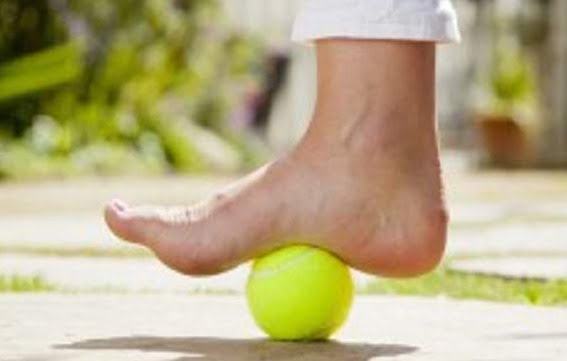
7. Hamstring Self Massage
For Hamstring Self Massage
If you tend to be seated a lot, you probably have a lot of tightness in your hamstrings, which is the group of muscles at the back of your upper legs. Try this simple exercise for leg pain relief.
What you’ll need – Foam Roller
How to do it:
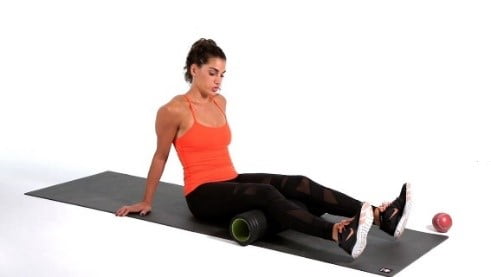
Looking after yourself during these times of working from home are very important for physical and mental health.
To find out more and cover topics such as exercises, ergonomics and self help advice, book and online virtual massage Telehealth appointment today with Yvette or Kody.
Step Into Health Care also sell a range of massage balls, heat packs and foam rollers to help you with home based self massage.
Book online today at www.stepintohealthcare.com.au where your health is our top priority!

